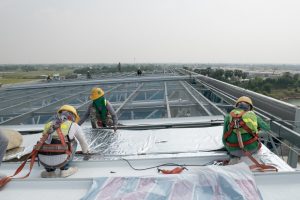Roof maintenance is essential for both homeowners and property managers. A well-maintained roof extends the lifespan of the structure and prevents costly repairs down the road. In this guide, we’ll explore key topics like identifying early signs of roof damage, selecting the right contractors, and choosing suitable materials for new installations. By the end, you’ll have the knowledge to make informed decisions about your roofing needs.
A roof plays a critical role in protecting your property, whether it’s a single-family home or a multi-family building. Over time, roofs can develop issues such as leaks, cracks, and wear that, if left unaddressed, can escalate into significant problems requiring extensive repairs or even full replacement. Proper care and regular inspections are essential to prevent these issues.
This comprehensive guide will help you understand the essentials of roof care. We’ll discuss how to spot early signs of damage, what to consider when hiring contractors, and when restoration might be a more economical choice than replacement. Whether you’re planning for immediate repairs or long-term solutions, this article will provide the insights you need to keep your roof in optimal condition.
- How to Spot Early Signs of Roof Damage
- What to Look for When Hiring a Roofing Service Provider
- How Specialists Assess Roof Damage Effectively
- When a Restoration is Better Than a Full Replacement
- Key Signs That a Full Replacement is Necessary
- How to Ensure You’re Hiring Trustworthy Contractors
- Factors to Think About Before Starting a Roof Installation
- Why Metal Roofs Could Be a Smart Investment
- Immediate Repairs vs. Long-Term Solutions for Your Roof
- Special Considerations for Multi-Unit Roofing Projects
- Conclusion
How to Spot Early Signs of Roof Damage
Identifying early signs of roof damage can save you from expensive repairs in the long run. One of the first signs of trouble is a leak inside your home. While visible water stains on ceilings or walls are obvious indicators, other subtler signs include peeling paint and mold growth. Such evidence suggests water penetration, necessitating immediate attention.
Additionally, regular roof inspections can help in spotting issues early. Look for missing shingles, cracked tiles, and sagging areas, as these could be indicators of underlying damage. Often, these problems can be addressed quickly if caught early, preventing the need for more extensive roof repair efforts.
Moreover, checking your roof’s drainage system is crucial. Clogged gutters can cause water to pool on the roof, leading to material deterioration and leaks. Ensuring that gutters are clear can prevent unnecessary damage and prolong the life of your roof. Always keep an eye out for these early signs to maintain the health of your roof.
What to Look for When Hiring a Roofing Service Provider

When choosing a residential roofing company, several factors should influence your decision. First, ensure that the company is licensed and insured. This protects you from liability in case of accidents during the roofing project. Don’t hesitate to ask for proof of insurance and licensing before committing to a service provider.
Experience is another crucial factor. Look for a company with a solid track record in roof repair and installations. A roofing service with years of experience will likely have encountered various types of roofing issues and will be better equipped to handle your specific needs efficiently.
Lastly, consider customer reviews and testimonials. Reviews provide insights into the company’s quality of work and customer service. A reputable residential roofing company will have positive feedback from satisfied customers. By considering these factors, you can find a trustworthy roofing service provider to meet your needs.
How Specialists Assess Roof Damage Effectively
Roofing experts utilize a systematic approach to assess roof damage effectively. The first step often involves a visual inspection from both the ground and the rooftop. This allows the roofing expert to identify any visible signs of damage such as missing shingles, cracks, or sagging areas.
In addition to the visual check, specialists use advanced tools like infrared scanners to detect underlying issues. These devices can spot problems hidden beneath the surface, such as water intrusion or material degradation. This comprehensive assessment ensures that all potential issues are identified and addressed.
Lastly, experts may take core samples to analyze the condition of the roofing material. This helps in determining the extent of damage and whether a roof repair or replacement is necessary. By using a combination of techniques and tools, roofing experts can provide a thorough evaluation of your roof’s condition.
When a Restoration is Better Than a Full Replacement

Roof restorations can be a cost-effective alternative to full replacements under certain conditions. If the roof’s structure is still sound but the surface materials have deteriorated, a restoration can rejuvenate the roof’s appearance and functionality. This option is especially viable for newer roofs that have started showing signs of wear and tear but are not structurally compromised.
Restoration involves cleaning, repairing, and re-coating the roof. These steps can prevent further damage and extend the roof’s lifespan by several years. Another advantage of roof restorations is that they are less disruptive and time-consuming compared to full replacements. This is particularly beneficial for property owners who want to minimize downtime.
Additionally, restorations are often more environmentally friendly. By reusing existing materials, you reduce waste that would otherwise end up in landfills. This makes restoration an attractive option for those looking to minimize their environmental footprint. Always consult a roofing expert to determine if a restoration is suitable for your roof.
Key Signs That a Full Replacement is Necessary
While restorations can be beneficial, certain signs indicate that a full roof replacement is inevitable. One of the primary indicators is extensive water damage. If leaks are widespread and cause significant damage to the interior structure, a roof replacement may be the only viable solution to prevent further deterioration.
Another sign that points to the need for a roof replacement is the presence of mold and mildew. These fungi thrive in moist environments and can cause significant health issues. If mold and mildew infestation is severe, a complete roof replacement is often recommended to eliminate the problem and ensure a healthy living environment.
Age is also a critical factor. Most roofing materials have a lifespan of 20-30 years. If your roof has reached or exceeded this age, it may be time for a new roof installation. An aging roof is more susceptible to damage and may not provide adequate protection against the elements, making a replacement a prudent choice.
How to Ensure You’re Hiring Trustworthy Contractors

Hiring quality roofers is crucial for the success of your roofing project. Start by asking for recommendations from friends, family, or colleagues who have recently had roofing work done. Word-of-mouth referrals are often reliable and can help you find trustworthy contractors.
Once you have a list of potential contractors, check their credentials. Ensure they are licensed and insured, as this protects you from liability in case of accidents. You can verify their credentials with local licensing authorities or professional organizations. This step helps in filtering out unqualified contractors.
Lastly, request multiple quotes and compare them. This not only gives you a sense of the market rate but also allows you to gauge the contractors’ professionalism. Quality roofers will provide detailed, written estimates and be willing to answer any questions you may have. By taking these steps, you can ensure you’re hiring trustworthy contractors for your roofing needs.
Factors to Think About Before Starting a Roof Installation
Before embarking on a new roof installation, several factors need to be considered. First, choose the right roofing material. Factors such as climate, aesthetic preferences, and budget will influence this decision. Popular options include asphalt shingles, metal roofing, and tile. Each material has its pros and cons, so it’s essential to consult with a roofing expert.
Second, consider the timing of the installation. Weather conditions can significantly impact the installation process. Ideally, the project should be scheduled during dry seasons to avoid delays and complications. Proper planning can ensure a smoother installation and better results.
Lastly, think about the long-term maintenance of your new roof. Different materials require varying levels of upkeep. For example, metal roofing is known for its durability and low maintenance requirements, while asphalt shingles may need more frequent inspections and repairs. Understanding these maintenance needs can help you make an informed decision.
Why Metal Roofs Could Be a Smart Investment

Metal roofing has gained popularity in recent years due to its numerous benefits. One of the primary advantages is its durability. Metal roofs can last 40-70 years, far longer than traditional asphalt shingles. This longevity makes metal roofing a cost-effective investment in the long run.
Another benefit is energy efficiency. Metal roofs reflect solar radiant heat, which can reduce cooling costs by 10-25%. This makes metal roofs an excellent choice for homes in hot climates. Additionally, metal roofing materials are often made from recycled content and are fully recyclable at the end of their lifespan, making them an environmentally friendly option.
Lastly, metal roofs are highly resistant to fire, wind, and impact. This makes them ideal for areas prone to severe weather conditions. While the initial cost of metal roofing may be higher than other materials, the long-term benefits often outweigh the upfront investment, making it a smart choice for many homeowners.
Immediate Repairs vs. Long-Term Solutions for Your Roof
When dealing with roof issues, it’s essential to weigh the benefits of immediate repairs against long-term solutions. Immediate repairs, such as fixing leaks or replacing missing shingles, provide quick relief from urgent problems. These fixes are often less costly and can temporarily extend the life of your roof.
However, for recurring issues or extensive damage, long-term solutions may be more cost-effective. For example, if your roof has suffered significant storm damage, a comprehensive storm damage roof repair or replacement might be necessary. These options address the root cause of the issues, providing a more durable solution.
Consulting with a roofing expert can help you determine the best course of action. They can assess the extent of the damage and recommend whether immediate repairs or long-term solutions are more appropriate. This ensures that your roof remains in optimal condition for years to come.
Special Considerations for Multi-Unit Roofing Projects
Multi-unit roofing projects come with unique challenges that require careful planning and coordination. One of the primary considerations is the scope of the project. Multi-family roofing contractors must assess each unit’s condition individually while ensuring that the entire complex maintains a cohesive appearance.
Another critical factor is minimizing disruption to residents. Coordinating with tenants to schedule work times that are least disruptive is essential. Clear communication about the project timeline and any potential inconveniences can help in maintaining good tenant relations during the roofing project.
Lastly, consider the long-term maintenance needs of the roofing system. Multi-unit properties often have shared roofing structures, so it’s crucial to choose durable materials and designs that require minimal upkeep. This not only reduces long-term costs but also ensures the safety and comfort of all residents.
Conclusion
Maintaining your roof is crucial for the longevity and structural integrity of your property. From spotting early signs of damage to making informed decisions about repairs, restorations, and replacements, this guide has covered essential aspects of roof care. Understanding what to look for in a residential roofing company and ensuring you hire trustworthy contractors can make all the difference in the quality of work you receive. Additionally, considering the benefits of metal roofing and weighing immediate repairs against long-term solutions can help you make the best choices for your specific needs. For multi-unit properties, special considerations must be taken into account to ensure minimal disruption and long-term sustainability. By following the insights and tips provided in this guide, you can ensure that your roof remains in optimal condition for years to come.
Remember, regular roof inspections, proper maintenance, and addressing issues promptly are key to preventing costly repairs and ensuring the safety of your property. By investing time and resources into roof care, you’re safeguarding one of your home’s most vital components. A well-maintained roof not only protects your property but also enhances its overall value. Don’t hesitate to consult with a roofing professional for personalized advice and assistance in maintaining your roof’s health. Taking proactive steps to care for your roof can provide peace of mind and significant long-term savings.






